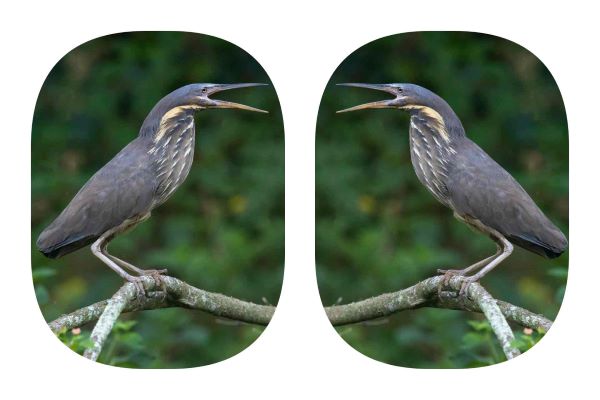Family: Black Bittern (Ixobrychus flavicollis) is a member of the family Ardeidae in the genus Ixobrychus.
Identification: The male upper surface, wings, and face are plain sooty-slate; a patch of straw plumes at the sides of the neck. The throat and fore-neck are white, mottle-striped, and sooty-brown. Underside: brownish slate. Face skin is yellow-brown to dusky. The eyes are pale yellow. The bill is dusky above and yellowish grey below. Legs and feet are slate-brown. Early in breeding, eyes are reddish, face skin is violet-pink, bills are red-tinged, and feet are dull yellow. The female bird is browner and paler than the male; it has a rufous flush on the cheeks. The immature bird is browner, scalloped, and buff on the body. The feet and legs are brown-gray. The irises are yellow, and the lores are green-brown. The downy young bird is plain white with a light brown tinge to the neck and rump.

Distribution: The black bittern is found in forested fresh rivers and inlets of the eastern, northern, and western mainland coasts; the black bittern breeds in tropical Asia, including Pakistan, India, Bangladesh, Sri Lanka, Indonesia, Papua New Guinea, and the Solomon Islands to the east of China.
Habitat: The Black Bittern is the largest of the small bitterns and may also boom when breeding and fan the distinctive plumes at the side of its neck in display. Both sexes nest-build, incubate, and feed young; they also forage and roost alone, holding set feeding and breeding territories. Given their hiding habits and preference for reed beds, they can be hard to spot, but when their all-black upperparts make them obvious, they tend to fly rather regularly. When disturbed, it flies quickly or runs to hide himself in covers.
Vocalizations: Black bittern call is cooing coo-oorh, repetitive eh-eh, eh-he at nest; boom from perch. The alarm croaks when flushed.
Nesting and Breeding: The black bittern nesting and breeding occur in September-March. Nests are made of sticks, in trees over water, or on reed platforms in shrubs.
Eggs and Incubation: The bird lays up to six bluish-white eggs, rounded-oval, about 44 x 35 mm. The incubation is done by both sexes.
Diet: By day, they rest in waterside vegetation and come out at dusk and dawn to hunt for fish, amphibians, molluscs, and insects. If disturbed, they fly to a perch and freeze like a stick.
Movements: The black bittern is usually sedentary and resident, and some northern birds migrate short distances.
Other Names: It is also known as Yellow-necked Bittern and Mangrove Bitten.
Measurement: Black bittern measures about 570–650 mm in length, with an average weight is about 850–900 grams. As compared to similar species, it has a longish neck and a long yellow bill.
Similar Species: Striated Herons (Butorides striatus) are also found in mangroves, although they are smaller (up to 49 cm) and have a black cap on their lighter grey body than Black Bitterns.
Races: There are three races, but only one large species is found in Australia.
Read More: The Mesmerizing Great Blue Heron
